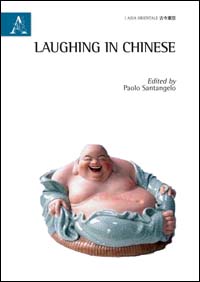Laughing in Chinese
A cura di Paolo Santangelo
Alessandra Aresu, Salvatore Attardo, Paola Bonifacci, Roberto Caterina, Silvana Contento, Elena De Rossi Filibeck, Paolo De Troia, Pier Luigi Garotti, Pi-ching Hsu, Iolanda Incasa, Rudolf Pfister, Pio Enrico Ricci Bitti, Erhard Rosner, Wolfgang Schwabe, Stefania Stame, Maria Gioia Vienna, Lee Cheuk Yin
Alessandra Aresu, Salvatore Attardo, Paola Bonifacci, Roberto Caterina, Silvana Contento, Elena De Rossi Filibeck, Paolo De Troia, Pier Luigi Garotti, Pi-ching Hsu, Iolanda Incasa, Rudolf Pfister, Pio Enrico Ricci Bitti, Erhard Rosner, Wolfgang Schwabe, Stefania Stame, Maria Gioia Vienna, Lee Cheuk Yin
Area 10 – Scienze dell'antichità, filologico-letterarie e storico-artistiche
Tweet
SINTESI
Does the Latin maxim “risus abundat in ore stultorum” (laughter is plentiful in the mouth of fools) work also in East–Asian cultures? Can we find a “laughing Democritus” and a “crying Heraclitus" also in these cultures? Anyway, Budai Monk was praised by Feng Menglong as his master, because “laughable is talking about something we doubt, and even more laughable is talking about something we believe: the Classics, the Philosophers and the Histories, are just nonsense, and yet people compete to transmit them. Poems and compositions are just idle chat, and yet people compete to produce them. Praise and ridicule, promotion and dismissal are just confusing tales, and yet people contend in following and avoiding them.” Smiles and laughter are phenomena that have been mainly studied by psychologists and experts of human communication, but in fact pose some key questions to the philosopher, on the way to express what cannot be explained by words, and are also of interest to anthropological and ethnological researches, since they provide a valuable source of information about the emotional attitudes and social interactions within a given society, and thus about the culture in which they are produced or represented. In fact smiling and laughing do not only manifest a state of mind, but they are also social acts at the same time. And as social acts performed in systematic and socially organized patterns, they play an extremely important role in human interrelations, communication and interactions. Literary texts, artistic works and mass-media productions frequently offer us some hints about the cultural dimension of human smiling and laughing. By comparing the philological studies of some scholars dealing with East Asian cultures — mainly Chinese civilization — with the experimental results by psychologists, we aim at elucidating some aspects of human behaviour through an interdisciplinary and intercultural approach, taking advantage of the various different specializations of the contributors.
| pagine: | 472 |
| formato: | 17 x 24 |
| ISBN: | 978-88-548-4620-3 |
| data pubblicazione: | Maggio 2012 |
| marchio editoriale: | Aracne |
| collana: | Asia orientale 古今東亞 | 8 |

SINTESI
INDICE
EVENTI













